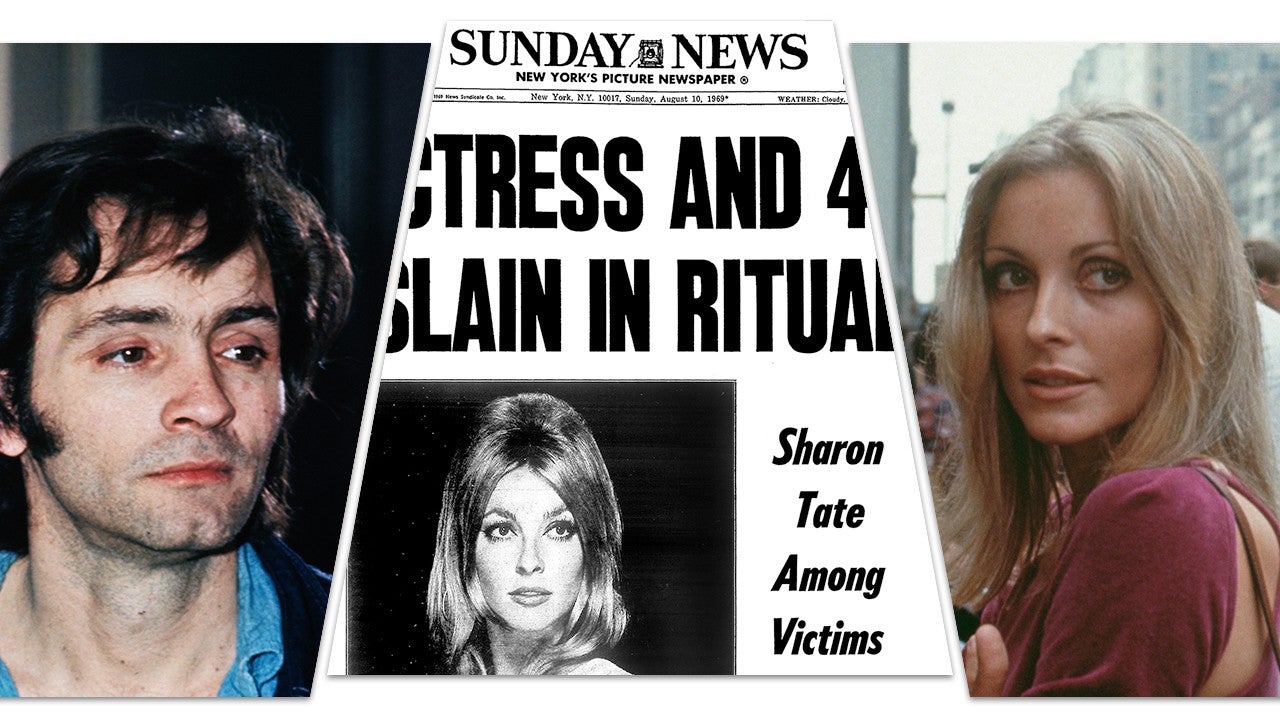Quentin Tarantino’s new film, Once Upon a Time in Hollywood, sets the fictional story of two aging TV actors against the backdrop of the rise of the Manson Family and the 1969 murder of Sharon Tate. Meanwhile, season two of Netflix’s Mindhunter, David Fincher’s scripted drama about FBI investigators profiling serial killers, takes place during the late-’70s and early-’80s and will visit Charles Manson, who was sent to prison in 1971 after he was convicted on several counts of first-degree murder. With both projects bringing additional focus to the 50th anniversary of the tragedy, ET takes a closer look at the key people involved and the events leading up to Aug. 8-9, 1969.
Charles Manson
By the time audiences meet Manson in Once Upon a Time in Hollywood, he’s the leader of a fully-fledged cult mostly comprised of female followers who have taken up residence at the Spahn Ranch, land in Los Angeles County that was previously used to film western-themed movies and TV series.
Born in Cincinnati, Ohio, Manson’s migration to the West Coast was a crime-filled journey, with burglaries, armed robberies and stealing cars. His crimes got him sent to juvenile facilities before he landed in prison thanks to escalating offenses and parole violations. Between prison stays, he traveled to Los Angeles with his the- wife, Rosalie Jean Willis, who later divorced him. Settling into prison life, Manson picked up the guitar and befriended gang leaders and inmates with Hollywood connections. While he wasn’t keen on leaving, having spent nearly half of his life behind bars, he was eventually released from the prison system in 1967.
The Manson Family
Thanks to the free love social movement, known as the “Summer of Love” in 1967, Manson was able to re-establish himself as a guru shortly after moving to San Francisco. It didn’t take long for him to collect followers, mostly young women, who believed they were reincarnations of the original Christians and that Manson himself was a manifestation of Jesus. The earliest followers included Mary Brunner, Lynette “Squeaky” Fromme, Patricia Krenwinkel and Susan “Sadie” Atkins, who gave birth to the Family’s first child, as well as Bruce Davis, who was Manson’s first dedicated male follower and became his right-hand man.
Eventually, in 1968, the Manson Family moved to Spahn Ranch, which was no longer being used regularly as a film set, after bartering chores and sex with the nearly blind, 80-year-old owner, George Spahn. (In Tarantino’s film, Spahn is portrayed by Bruce Dern in a brief, but electric scene.) It was there, the cult, which was fueled by drug use and sex orgies, continued to expand and Manson’s prominence took hold.
The ever-expanding Family now included Bobby Beausoleil, Catherine “Gypsy” Share, an aspiring singer, Charles “Text” Watson, a University of Texas dropout, Dianne “Snake” Lake, a daughter of another commune who was granted permission by her parents to join Manson’s cult, Paul Watkins, a high school dropout, and Sandra “Blue” Good, another college dropout.
Dennis Wilson
In 1968, as the Family continued to grow, the Beach Boy picked up two members who were hitchhiking and brought them to his Pacific Palisades home. Following the meeting, Manson would soon ingratiate himself in Wilson’s world, writing and recording music together and enjoying the pleasure of a growing number of women that moved freely in and out of the performer’s house.
With the Family now in the Los Angeles area, Manson’s Hollywood interactions -- including Angela Lansbury’s daughter, Deirdre Shaw, who was a brief, part-time member -- would quickly grow. It was Manson’s relationship with Wilson, however, that would eventually lead to his fateful encounter with Sharon Tate. The drummer introduced Manson to his acquaintances, including songwriter Gregg Jakobson, musician Terry Melcher and Rudi Altobelli, who owned the house where Tate was living at the time of her death.
Sharon Tate
On March 23, 1969, Manson briefly met Tate, a rising actress who appeared in Don’t Make Waves and Valley of the Dolls, after the cult leader showed up to 10050 Cielo Drive, Altobelli’s property, where he believed Melcher was staying. In fact, Melcher was only a prior resident and the property had been rented out to Tate and her husband, director Roman Polanski.
Born in Dallas, Texas, Tate was regarded for her beauty and began competing in pageants as a teen. In 1960, when her father was stationed in Italy, she moved to Verona with her family and was eventually noticed by actor Richard Beymer, who encouraged her to pursue acting. When her family moved back to the U.S. in 1962, Tate headed to Los Angeles to make a go of Hollywood, picking up small parts on The Beverly Hillbillies and Mister Ed. Two years later, she met Jay Sebring, a leading hairstylist, whom she dated until she met Polanski while working on the film The Fearless Vampire Killers. Despite the switch in beaus, Polanski, Sebring and Tate would all stay friends.
In Once Upon a Time in Hollywood, audiences meet Tate (portrayed by Margot Robbie) on the opening weekend of her latest film, The Wrecking Crew, in February 1969. By that time, Tate and Polanski were married and soon she would be pregnant with their first child. In the coming months, she would shoot what would become her final role as Pat in the comedy, The Thirteen Chairs.
Helter Skelter
In the year leading up to the murders of 1969, Manson first heard The Beatles album known as the White Album, which includes the track, “Helter Skelter.” Manson became obsessed with the band’s music and started preaching to his Family that “Helter Skelter” was a coded prophecy about an apocalyptic war caused by racial tensions between African Americans and Caucasians. In the 2009 documentary Manson, Share explained that “when the Beatles’ White Album came out, Charlie listened to it over and over and over and over again. He was quite certain that the Beatles had tapped into his spirit.”
“He thought that the Beatles were talking about what he had been expounding for years,” she continued. “Every single song on the White Album, he felt that they were singing about us. The song ’Helter Skelter’ -- he was interpreting that to mean the blacks were gonna go up and the whites were gonna go down.”
While living on Spahn Ranch, the Family began preparing for the war by working on songs for an album that would set the prophecy into motion while they prepared their escape. (“Helter Skelter” supposedly included a coded route they would use.) Believing that the war would start in the summer of 1969, Manson was in a rush to complete the album, which still wasn’t finished by May.
The 1969 Murders
Hoping to spark “Helter Skelter,” Manson believed that strategic murders would need to be executed by the Family, the first of which was the shooting of African-American drug dealer Bernard Crowe on July 1. Manson thought that the killing of a black man would spark retaliation by the Black Panthers.
Later, the Family turned on Gary Hinman, a music teacher who befriended some of the members and opened up his home to them. Believing that he had money that could benefit the cult, Manson ordered Atkins, Beausoleil and Brunner to convince Hinman to turn over all his assets to the group. After he declined, he was held hostage for two days before he was stabbed to death on July 27 by Beausoleil. (Beausoleil was later arrested on Aug. 6.)
On Aug. 8, Atkins, Krenwinkel, Watson and Linda Kasabian were ordered by Manson to go to 10050 Cielo Drive and kill everyone, including Polanski and Tate. That night, the group killed the five people there: Tate, who was eight months pregnant, Sebring, coffee heiress Abigail Folger, aspiring screenwriter Wojciech Frykowski, and Steven Parent, who was visiting the property’s caretaker that lived in the guest house.
The following night, Leslie Van Houten, Steve “Clem” Grogan and Manson joined the other four Family members to execute Manson’s orders to murder the occupants of 3301 Waverly Drive. The owners of the home were supermarket executive Leno LaBianca and his wife and dress shop owner, Rosemary.
There were other victims in the Manson Family murders, including stuntman Donald “Shorty” Shea, who was killed weeks later, on Aug. 26, by Davis, Grogran and Manson. In November of 1972, Vietnam veteran James L.T. Willett was found dead by a hiker and the body of his wife, Lauren Willett, was found buried in the basement where several remaining members lived at the time.
The Trial and Aftermath
After months of investigation, the Family members and Manson were eventually all arrested, tried and convicted of various crimes for their involvement in the murders. Manson’s trial was a bit of a spectacle, notably for Manson’s attempt to defend himself, the Family’s ongoing disruption of the proceedings from inside the courthouse and later, Manson’s attempt to attack the judge. Kasabian, who was deemed a witness to the events on Aug. 8, was the only one not tried; instead, she was granted immunity for her testimony.
Manson, who was convicted on seven counts of first-degree murder and one count of conspiracy to commit murder, would serve out a life sentence behind bars until his death on Nov. 19, 2017. He was later convicted of two additional counts of first-degree murder. In the 1980s, when Mindhunter picks up with Manson, the former cult leader gave multiple interviews to the press, including Charlie Rose and Geraldo Rivera.
The other living convicted Family members, including Krenwinkel and Watson, are still incarcerated, serving out their life sentences.
RELATED CONTENT:


